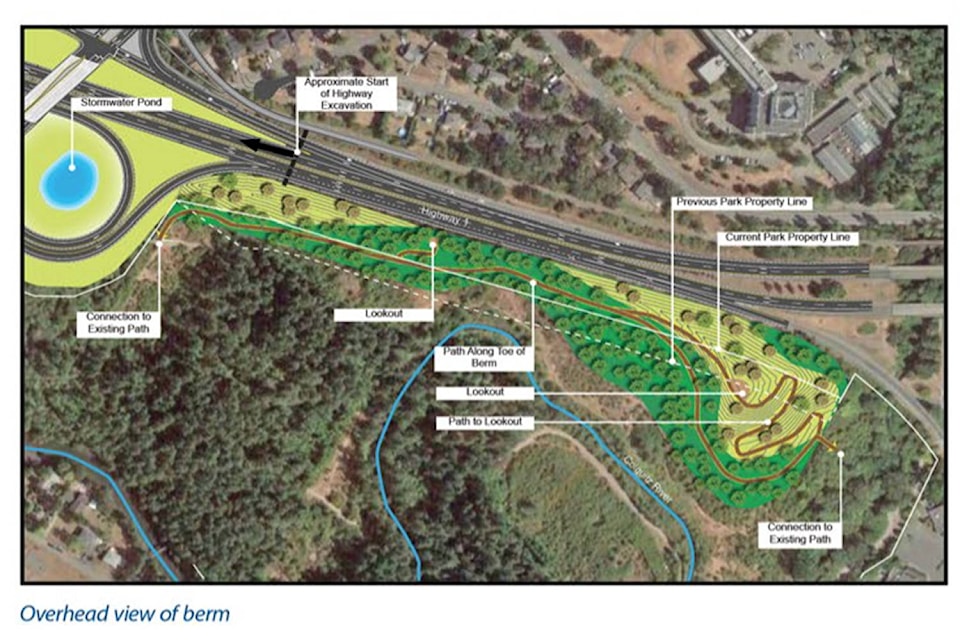Provincial officials presenting plans for a controversial highway berm faced tough, sometimes hostile questions at Saanich council Monday night and their answers did not satisfy councillors, who asked staff to get some additional answers from the Ministry of Transportation and Infrastructure.
“Yes, we all like the berm, but the devil is in the details,” said Coun. Colin Plant, who raised a number of questions about the proposal presented Monday night. Others agreed. “Quite frankly, I’m disappointed in the ministry,” said Coun. Judy Brownoff, who noted that the ministry had months to be ready to answer questions, only to appear unprepared.
Key among the unanswered question was the height of the berm.
It is part and parcel of the McKenzie Interchange Project, the $85-million-project designed to improve traffic flow through the intersection of McKenzie Avenue and the Trans Canada Highway through a partial ‘cloverleaf’ ramp system.
The ministry plans to build the berm out of soil that construction crews are currently excavating to lower the highway. Iinitial plans presented to the public in the spring called for a berm that would be 500 metres long and 14 metres above the existing ground level or 11 metres above the highway at its southern end, a figure prompting concerns from local environmentalists.
The higher the slope, the less stable the berm could be, a concern for environmentalists, who fear material coming off the berm could enter and damage Colquitz Creek, a salmon-bearing river.
“I don’t know the height off hand, I don’t have that information in front of me,” said David Edgar, district planning engineer with the ministry during a presentation before council. Just minutes earlier, he had told councillors that the ministry had lowered the height of the berm following public input. “Since the open house [this spring], we have re-designed the berm to make the slopes less steep,” he said. But neither he nor Mike Dinney, senior project manager, could offer a specific number, when several councillors including Coun. Colin Plant and Coun. Fred Haynes pressed Edgar.
Coun. Fred Haynes said he is “puzzled” that the ministry would not be able to offer an answer to such an important question at this stage. Saanich could be responsible for a host of “unknown liabilities” if the berm were to slip following a heavy rain, said Haynes. “I’m concerned about the height of your berm and the distance from Colquitz Creek,” he said.
The supposed height change also surprised Julian Anderson, lead steward for the Friends of Cuthbert Holmes Park, who had previously expressed concerns about the height of the berm. Anderson said during a brief presentation before council that Dinney had confirmed to him that the proposal under consideration was the proposal presented to the public in April.
“If they have changed it, they [MoTI] haven’t told anybody,” said Anderson, who repeated his earlier concerns about the berm. “It is just too steep, it is just too large,” he said.
Another related line of questioning came from Brownoff, who asked Edgar how the berm would handle a “significant” volume of rain. Specifically, she wondered how the berm would change the park’s hydrology in light of forecasts that predict more voluminous rain events for the region in the face of climate change.
While Edgar could not give a specific answer, he promised that a whole host of professionals from the ministry would continue to work with Saanich staff.
Other questions meanwhile focused on provincial plans for managing invasive species.
“We got a design done, but we can fine-tune that design, working with Saanich staff,” said Edgar. He also repeated an earlier promise that the berm would not come within 30 metres of Colquitz Creek.
Edgar said during his presentation that the ministry could build a smaller berm on its own right-of-way, but such a structure would not satisfy the concerns of residents.
Janelle Erwin, deputy regional director for MoTI’s South Coast Region, said in a letter to council that the berm would protect Cuthbert Holmes Park against the audio-visual impacts of the Trans-Canada Highway, save taxpayers’ money by using the soil onsite rather than trucking off-site, remove non-native plants from the park in the area of the berm, and enhance the park by adding parkways, native trees and other plantings.
While one speaker spoke in support of the berm as presented, public opinion ran largely against the berm. “What we are not hearing is a committment to the park,” said Anderson, adding that ministry professionals could not prevent a violation of the 30-metre buffer for Colquitz Creek.
While he does not oppose the berm in theory, he questions the ministry’s proposal. “I understand they need to get rid of fill, but the park is not a dumping ground,” he said.
Saanich staff recommended approval of the berm, calling it an opportunity to improve the park.
Suzanne Samborski, Saanich’s director of parks and recreation, acknowledged that several questions remain unanswered. But staff, she said, have had a historically good working relationship with ministry in expressing confidence that staff would be able to come up with satisfactory solutions.
Several councillors, however, noted that MoTI would finalize design of the berm after council’s approval, a prospect that caused visible discomfort among councillors.
Council’s decision to send the berm proposal back for additional review comes after news that the McKenzie interchange project will not wrap until 2019, at least seven months later than the initial completion date.
The project from its very inception has also faced a long of criticisms from environmental and social activists. Construction has not always been smooth amidst reports of drilling and blasting keeping residents up at night and hundreds of gallons of raw sewage soiled the construction site earlier this year. Anderson also pointed that all of the ministry’s staff collectively failed to prevent a violation of the 30-metre buffer around Colquitz Creek.



